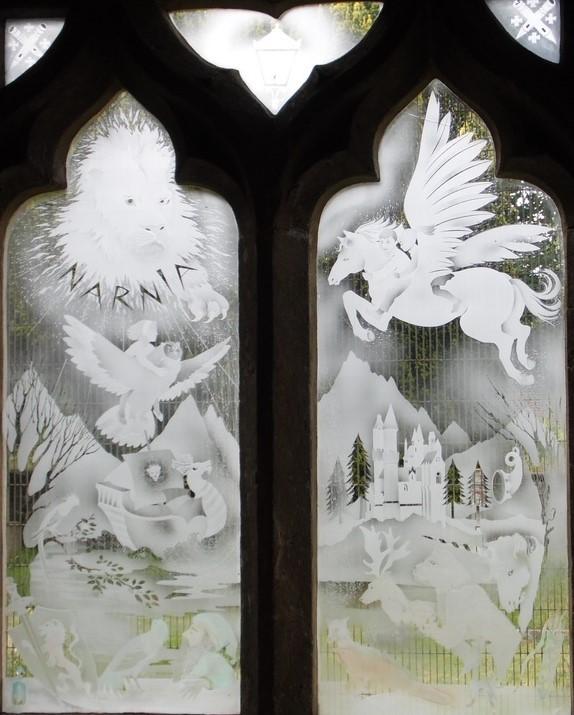
The Holy Trinity Narnia window in the north aisle is the Garden of Eden as C.S. Lewis described it: a landscape of talking animals, speaking trees, courage and kindness, shot through with the light from outside and physically very accessible: you need to be only four foot tall to see the animals crowding round the base of a scene which is crammed like a medieval painting, without perspective, everything going on at the same time. Above, the lantern in the trefoil, like the holy dove, sheds peace on what happens below. The Narnia window was created in 1991 as a memorial at once to the writer who sat in the pew by the window, and a joyful bequest to keep in mind two local children who had died very young four decades earlier.
The story of the window begins with the Howe Bequest made by George and Kathleen Howe, half of which was to be spent on a modern window as a memorial to their children. The idea of marrying the early deaths of William George Howe (1938-1954) and Gillian Margaret Howe (1945-1947) with Narnia, the earthly paradise created by C.S. Lewis, emerged from a discussion between Holy Trinity’s dynamic vicar Christopher Hewetson and the PCC on 28 January 1991. As the Revd Hewetson’s curate Elias Polomski recalls, “so many people came asking after C.S. Lewis and we felt we had to do something. We felt it should not compete with the other windows.” The inspiration came from the clear-glass engraved doors of Coventry Cathedral.
It was touch and go whether Holy Trinity might have featured something quite different. Christopher Hewetson wrote in the parish magazine that, ‘I have thought that we should consider a secular subject. Taking parallels from my last two parishes, I would be thinking in terms of steam trains (Didcot) and racehorses (Ascot). I don’t think either would be appropriate for commemorating in a stained-glass window, while they may feature in some lesser way.’ They didn’t feature. Instead, we got what Hewetson later called ‘this powerful Christian allegory’.
Sally Scott, artist and sculptural glass engraver, was commissioned to create the window. Sally likes working for churches: “I love the research and the scale,” though this commission was a small one compared to the eight panels of the western porch of Westminster Abbey that she had worked on the year before. Research “takes me down an avenue of exploration which I don’t normally do, sifting and sensing what would make sense for a particular site”.
After receiving the Narnia brief, she reread the books and measured up the windows. “In your head, the elements you want to use take shape,” such as the Narnia lantern in the trefoil window above. Then she produced her first designs. Her revised sketch appears on p58 of the Holy Trinity Headington Quarry Oxford 1849-1999 history. Because the window is at eye level, Sally was able to fill her pictures with activity. This degree of detail is unusual in a church window because most are high up, which means the glass designs need to be simple and bold. Here, “the scale is right for children.”
Focus on the gleaming glass and you see wonders: Aslan, great lion and creator, from whose mane streams light; two boys seated on a flying horse; a small girl flying on a talking owl, all of which are C.S. Lewis examples of courage, loyalty and endurance; and the castle Cair Paravel, which became the seat of good government on earth. Below are the heads of unicorn, bearded dwarf and antlered stag, mouse and small bird: no creature too odd or too small not to be filled with God’s grace and all have roles in the C.S. Lewis stories. Along the bottom are the magic gifts made to the children by Aslan: a bottle of healing elixir, a sword and shield, bow and arrow, and the horn that summons divine help.
You can see Sally Scott’s work locally in St Andrews, Headington; St John the Baptist, Stanton St John; and Holy Trinity, Ardington. The spots of warm pink at the bottom of both our windows, rising like blossoms of reviving heat, came about by committee decision: were the engravings to be pure white or enlivened with colour? The vote went 10 in favour of colour, 9 against. The colour is created by rubbing oil paint onto an abraded area of the glass.
The window was not installed by a Quarry stonemason but by an expert from further afield: John Baker of Weston-Super-Mare, though he nearly couldn’t complete the work: Sally’s record of the job includes the note: “John Baker has chicken pox. Will ring soon.”
The dedication service was held on 2 July 1991. Young people read passages from the stories about the creation of the world through Aslan, the mythical representation of Christ, and of his rising from death.
Three local children modelled the Narnia children: Margaret Cooper, Richard Holder and Rachel Wheeler.
Jemima Kallas
Thank you to Sally Scott, who threw her mind back over twenty years for this interview
